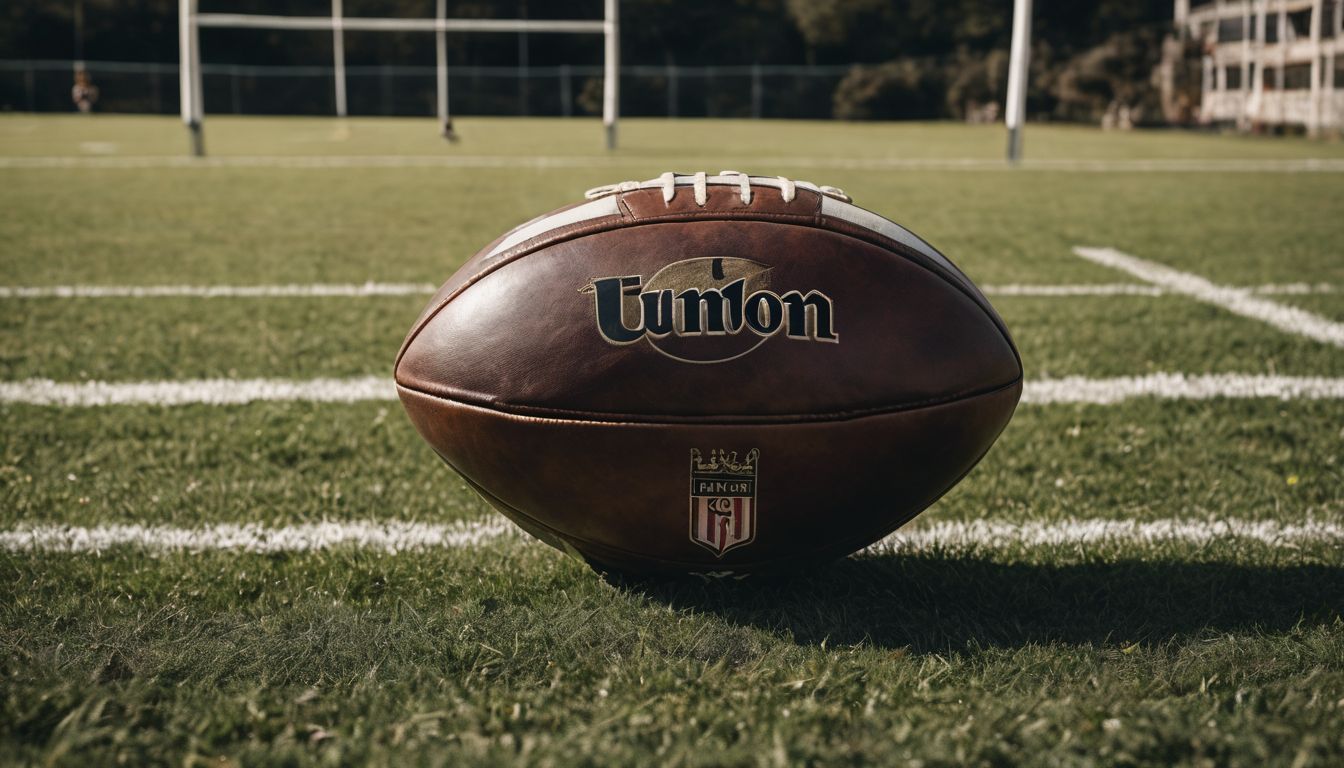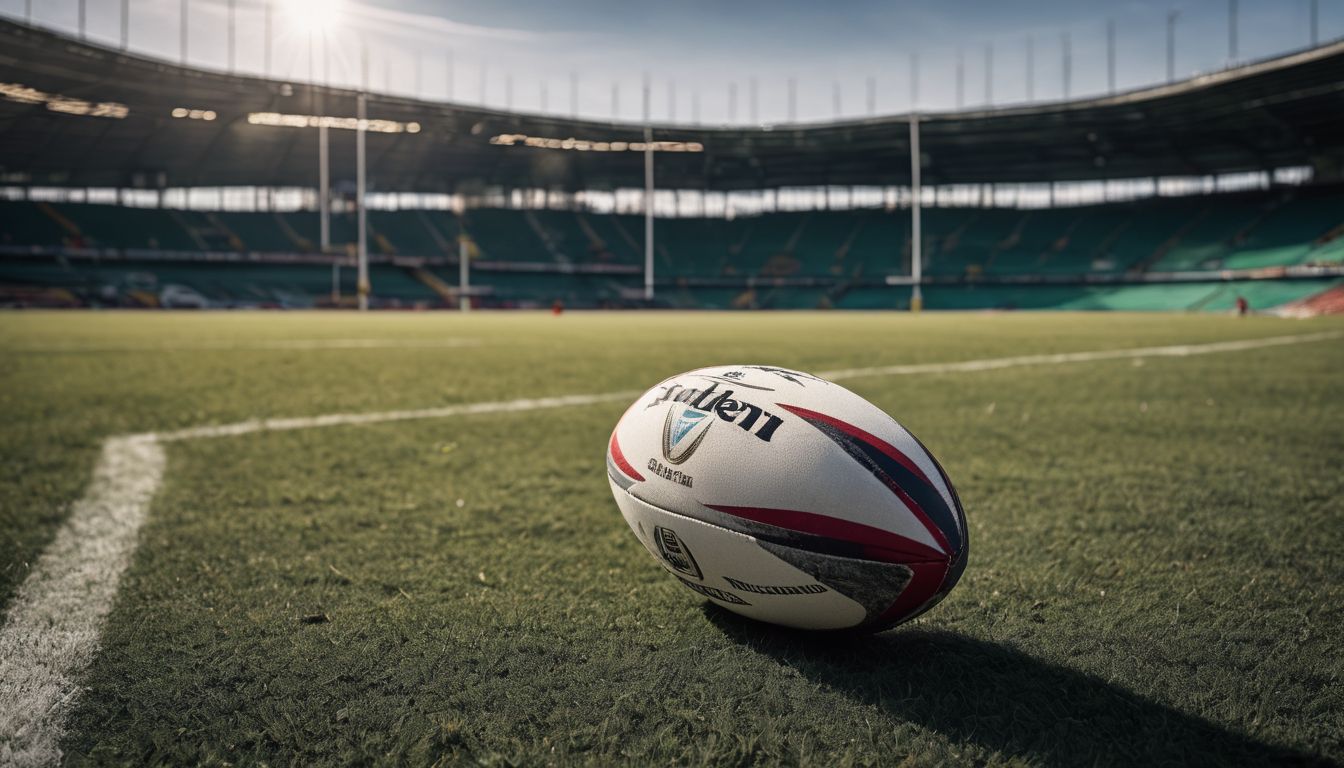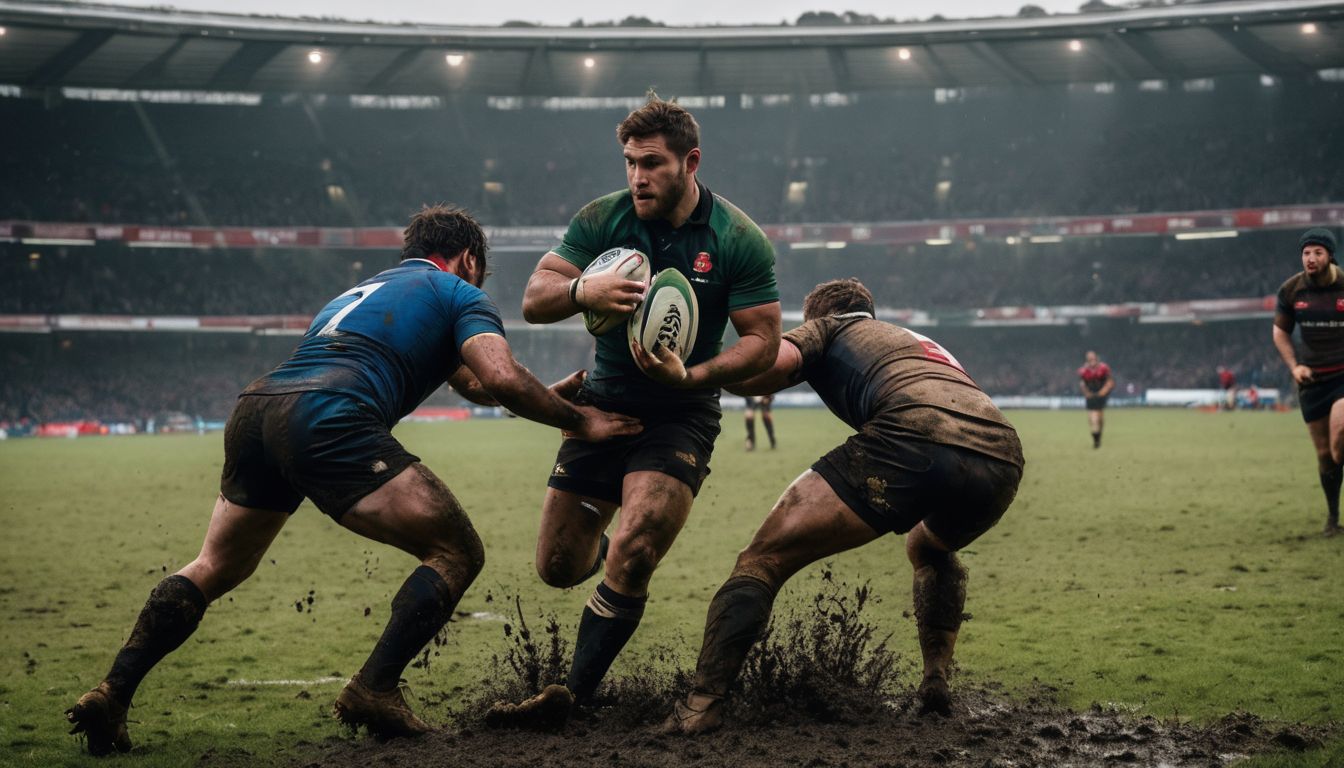Many of us have heard the roar of rugby fans and seen glimpses of powerful matches on TV, yet we might not fully grasp what the Six Nations Championship truly is. This historic contest has been igniting rivalries since 1883, making it a cornerstone in the world of rugby union.
Our blog post will unwrap this prestigious tournament for you, laying bare each fascinating detail from its hard-hitting origins to its modern-day triumphs. Read on for your guide to one of sport’s most exhilarating spectacles!
Key Takeaways
- The Six Nations Championship is an annual rugby competition between England, France, Ireland, Italy, Scotland, and Wales that started as the Home Nations Championship in 1883.
- It has evolved over time with the addition of teams; France joined in 1910 to create the Five Nations before it became Six Nations with Italy’s entry in 2000.
- Each year teams compete for various prestigious trophies like the Grand Slam and Triple Crown alongside their national pride. As of 2023, Ireland holds both titles.
- Key players often become legends within the championship with their records for scoring points or tries – Jonny Wilkinson being the all-time top point scorer and Brian O’Driscoll holding most tries scored.
- The tournament is managed by Six Nations Rugby Limited which promotes events and engages fans worldwide through effective marketing strategies.
History and Expansion of the Six Nations Championship
The Six Nations Championship has a rich history, evolving from the Home Nations to Five Nations and finally adding Italy as the sixth team in 2000. This expansion has brought together some of the best European rugby teams for an intense competition every year.
Evolution from Home Nations to Five Nations to Six Nations
Rugby’s roots stretch back to 1883 with the Home Nations Championship, a fierce contest among England, Ireland, Scotland, and Wales. This quartet of teams battled it out until France made an entrance in 1910, broadening the playing field and rechristening the event as the Five Nations.
Fast-forward to the turn of the millennium and Italy joined ranks in 2000, ushering in a new era for European rugby union – thus, giving birth to what we know today as The Six Nations Championship.
As each nation throws its strength into this historic tournament year after year, rivalries intensify and legends are born on its hallowed grounds. Next up: unpacking how these clashes unfold with “Addition of Italy as the sixth team in 2000“.
Addition of Italy as the sixth team in 2000
Italy made history in 2000 as it became the sixth team to join the prestigious Six Nations Championship, ushering in a new era for European rugby. This expansion marked a significant milestone, transforming the championship from the Five Nations to the Six Nations we know today.
With Italy’s inclusion, fans witnessed an exciting increase in competition and diversity, adding a fresh dynamic that has continued to shape the tournament’s landscape. Italy’s participation opened up new opportunities for players and further solidified the championship’s status as one of international rugby’s most anticipated events.
Italy’s addition brought about heightened anticipation each year with its presence alongside England, France, Ireland, Scotland, and Wales. The team’s entry into this esteemed competition not only elevated their own position within international rugby but also further diversified and enriched this renowned annual event.
Format and Trophies of the Six Nations Championship
The Six Nations Championship has a unique format with each team playing every other team once, resulting in 15 matches over six weeks. The championship also features prestigious trophies such as the Grand Slam and Triple Crown, adding to the excitement and rivalry between the teams.
Championship Trophy
The Championship Trophy is a prestigious symbol of success in the Six Nations Championship. The trophy, made of silver and standing at 75 centimetres tall, was first awarded in 1993.
It holds such significance that it’s known as the “Guinness Six Nations Trophy,” representing excellence and dedication on the rugby field. Teams battle fiercely for the honour of lifting this coveted trophy each year, with winners etching their names into rugby history.
Winning the Championship Trophy is a proud achievement for any national team, signifying their dominance and skill in one of Europe’s premier rugby tournaments. The glory of hoisting this revered trophy represents triumph over fierce competition and stands as a testament to exceptional teamwork and performance on the pitch every year.
Grand Slam and Triple Crown
The Grand Slam in the Six Nations Championship occurs when a team wins all of their matches in a single tournament. It is a remarkable achievement and highly coveted by all participating nations.
On the other hand, the Triple Crown refers to England, Scotland, Ireland or Wales winning against each other during the competition. Both are prestigious accolades that add another layer of excitement and intensity to an already thrilling rugby championship.
In 2023, Ireland secured both the Grand Slam and Triple Crown, showcasing their dominance throughout the tournament. These achievements not only demonstrate skill and determination but also earn immense respect from fans and fellow competitors alike.
Rivalry Trophies
The Six Nations Championship features several rivalry trophies that add extra excitement to the competition. These trophies are awarded to the winners of specific matches throughout the tournament, adding an extra layer of significance to those encounters. Each trophy has its own unique history and significance, reflecting the intense rivalries between the participating nations.
- The Calcutta Cup – This trophy is contested between England and Scotland and is one of the oldest rugby trophies in existence, first awarded in 1879. It symbolises the fierce rivalry between these two nations and is always keenly fought for during their annual fixture.
- The Millennium Trophy – This trophy is at stake when Ireland takes on England, representing the intense competition between these two sides. The tradition dates back to 1988 when Ireland hosted England at Lansdowne Road to commemorate the centenary of the first Home Nations match.
- Giuseppe Garibaldi Trophy – Italy and France compete for this coveted trophy, highlighting their competitive spirit and strong historical ties. The name honours Garibaldi, an Italian national hero who fought for both Italian and French causes in the 19th century.
- The Centenary Quaich – Awarded to the winner of matches between Ireland and Scotland, this trophy commemorates a century of rugby friendship between these two nations. It was introduced in 1989 to mark 100 years since these teams first played each other.
- Auld Alliance Trophy – France and Scotland contest this historic trophy named after “The Auld Alliance” – a significant historical connection between these two nations dating back to medieval times.
- Triple Crown – Though not a physical trophy, this honour is achieved by one of the Home Nations—England, Ireland or Wales—if they manage to defeat all three of their rivals during a single Six Nations tournament.
Venues and Results of the Six Nations Championship
The Six Nations Championship has a rich history spanning over a century with various format changes and additions of teams. The tournament has seen different venues host the matches, leading to thrilling results and intense rivalries between the teams.
Overall Results
Rugby enthusiasts have witnessed the evolution of the Six Nations Championship, a testament to the raw passion and heritage of the sport. England leads the pack with the most victories, showcasing their dominance in European rugby. Below is a summary of the overall results in the tournament’s history, highlighting the triumphs and tribulations of the competing nations.
| Period | England | France | Ireland | Italy | Scotland | Wales |
|---|---|---|---|---|---|---|
| Home Nations (1883-1909) | 5 | – | 4 | – | 9 | 7 |
| Five Nations (1910-1931) | 6 | 1 | 4 | – | 4 | 8 |
| Home Nations (1932-1939) | 4 | – | 2 | – | 1 | 5 |
| Five Nations (1940-1999) | 17 | 12 | 6 | – | 5 | 15 |
| Six Nations (2000-present) | 7 | 6 | 5 | 0 | 1 | 6 |
Ireland holds the championship title from 2023, fuelling expectations for their performance in the current tournament. Enthusiasm mounts as fans follow each match, waiting to see who will claim supremacy in the 2024 Six Nations Championship. Now, let’s turn our attention to the Wooden Spoon, a less coveted accolade, but one that stirs up its own lively debates among supporters.
Home Nations (1883-1909)
Transitioning from the overall results of the Six Nations Championship, let’s delve into its origins as the Home Nations (1883-1909). At its inception in 1883, the tournament involved only England, Scotland, Ireland, and Wales. The first-ever international rugby competition took place between these four nations and laid the foundation for what would eventually become one of the most prestigious events in men’s rugby union. During this period, England established itself as a dominant force by clinching numerous championship titles.
Playing on hallowed grounds and fueled by national pride, these early matches set the stage for decades of intense rivalry and unforgettable moments that have shaped the rich history of this esteemed championship.
Five Nations (1910-1931)
The Five Nations Championship, which ran from 1910 to 1931, included England, Scotland, Ireland, Wales, and France. This expansion marked a significant milestone in the tournament’s history as it transitioned from the original Home Nations format to encompass five European rugby teams. During this period, fierce rivalries emerged among these nations, captivating passionate fans and drawing large crowds to stadiums. The championship witnessed intense battles on the field as each team vied for supremacy over their rivals.
As international competition intensified and the fan base grew across Europe during this time frame of Five Nations Championships,
the teams displayed exceptional skill and sportsmanship while fiercely competing for the prestigious title.
Home Nations (1932-1939)
Following the expansion of the tournament, the Home Nations Championship continued from 1932 to 1939 featuring England, Scotland, Ireland, and Wales. During this period, the championship saw fierce competition among these nations, with matches drawing significant interest from rugby fans. The teams showcased their skills and determination during these years, contributing to the rich history of the Six Nations Championship.
The Fourteen-year span between “Five Nations (1910-1931)” and “Home Nations (1932-1939)” was marked by intense rivalries and exceptional displays of rugby prowess by England, Scotland, Ireland, and Wales.
Five Nations (1940-1999)
From 1940 to 1999, the Five Nations Championship consisted of England, France, Ireland, Scotland, and Wales. During this period, intense rivalries among these nations led to thrilling matches that drew large crowds and television audiences. Notably, the tournament took a hiatus during World War II from 1940 to 1946 due to the global conflict.
Scotland achieved notable success during this era with four outright championship wins and two shared victories. On the other hand, England dominated in terms of Grand Slam triumphs with an impressive six titles. The competitive nature of the tournament continued throughout these decades, solidifying each nation’s place in rugby history.
Additionally important is that some tournaments witnessed closely contested battles where no team managed a Grand Slam win for several years at a stretch. These gripping competitions kept fans on edge as they passionately followed their national teams’ performances.
Six Nations (2000-present)
Since 2000, the Six Nations Championship has included Italy, making it a six-team tournament. Italy’s addition brought new competition dynamics and expanded the championship’s reach across Europe. The inclusion of Italy has added an exciting dimension to the tournament, with several close matches and thrilling upsets occurring throughout the years.
Each year, rugby fans eagerly anticipate the fixtures of this prestigious competition and follow its television broadcast with enthusiasm. The Six Nations (2000-present) period continues to showcase fierce rivalries, exceptional skill on display from all participating teams, and memorable moments that cement its status as one of the most coveted titles in international rugby.
Titles, Awards, and Records
Discover the prestigious Wooden Spoon, player awards, and all-time top point scorers and try scorers in the Six Nations Championship. Don’t miss out on the excitement of tracking these titles, awards, and records by staying up to date with the latest news!
Wooden Spoon
The Wooden Spoon is a dubious award in the Six Nations Championship, given to the team that finishes at the bottom of the tournament standings. This ignominious accolade highlights the struggle and disappointment faced by the last-placed team, adding an extra layer of competitiveness to avoid being awarded this dishonour.
Italy has received the Wooden Spoon most frequently since joining the competition in 2000, reflecting their challenges in adapting to elite-level rugby within a tough field of opponents.
As for England, they have earned it five times, while Wales and Scotland have each suffered this fate four times since 2000. The French and Irish teams have been recipients three times apiece over this period.
Player Awards
Players in the Six Nations Championship have the opportunity to earn prestigious awards based on their performance during the tournament. These accolades include titles such as Player of the Championship and Top Point Scorer.
The Player of the Championship is voted for by fans, recognising outstanding individual contributions to their team’s success throughout the competition. On the other hand, the Top Point Scorer award goes to the player who accumulates the most points through tries, conversions, and penalties during all matches.
Individual players also have a chance to make their mark on history with exceptional performances that may lead them to become part of records such as All-time top point scorers and try scorers in Six Nations history.
All-time top point scorers and try scorers
The all-time top point scorer in the Six Nations Championship is Jonny Wilkinson, with an impressive total of 277 points. Following closely behind is Ronan O’Gara from Ireland, who has scored 254 points throughout his career in the tournament. When it comes to try scorers, Brian O’Driscoll holds the record for the most tries in Six Nations history, scoring a remarkable 26 tries for Ireland. With a powerful presence on the field, Shane Williams from Wales follows with 22 tries to his name. Rugby fans eagerly anticipate each match to see if these records will be surpassed by current players making their mark on this prestigious stage.
Administration and Marketing
The Six Nations Championship is overseen by the Six Nations Rugby Limited, which manages the tournament and its commercial aspects. The organisation works on marketing partnerships to promote the event, including TV broadcasting rights and sponsorship deals.
The championship’s commercial success has led to increased viewership and a larger global fan base. Additionally, the Six Nations Championship generates significant revenue through ticket sales, merchandise, and hospitality packages, contributing to the overall growth and popularity of rugby in Europe.
The marketing efforts for the tournament focus on promoting matches across various media platforms, engaging fans through social media campaigns, and creating an all-encompassing rugby experience for supporters both at stadiums and online.
Latest News and Updates from the Six Nations Championship
Stay updated with the latest analysis, team previews, and match results from the ongoing Six Nations Championship. Get insights into player performances and exciting developments in the tournament.
Fantasy Rugby Geek analysis
Fantasy Rugby Geeks closely follow the Six Nations Championship, analysing player performances and providing insights into team strategies. With a keen eye on key stats like top point scorers and try scorers, they offer valuable data for fantasy rugby enthusiasts looking to build successful teams.
Understanding the impact of individual player contributions is crucial in fantasy rugby, and these geeks provide detailed analysis to help fans make informed decisions when selecting their fantasy teams.
Fantasy Rugby Geeks play an important role in keeping fans engaged with the tournament, offering expert opinions on match results, player form, and potential breakout stars. Their analysis adds another layer of excitement to the championship for fans who enjoy immersing themselves in the tactical side of the game.
Team previews and match results
The 2024 Six Nations Championship is currently in progress, with fans eagerly following the matches and results. Here is a brief overview of the team previews and match results so far:
- England: Having won their opening match against Italy, England is showing great promise as they aim to secure victory in the tournament.
- France: After a dominant performance against Scotland, France is seen as a strong contender for the championship title this year.
- Ireland: With an impressive win over Wales in their first match, Ireland is looking determined to defend their title from last year.
- Italy: Despite a tough start to the tournament, Italy continues to show resolve and determination in each match they play.
- Scotland: Following a closely contested match against France, Scotland is eager to bounce back and showcase their competitive spirit in the upcoming games.
- Wales: Despite initial setbacks, Wales remains optimistic and determined to turn things around as they head into upcoming fixtures.
Conclusion and Excitement for the Future of the Six Nations Championship.
Excitement surrounds the ongoing 2024 Six Nations Championship. Teams are fiercely competing for victory and national pride. Fans eagerly anticipate thrilling matches and memorable moments ahead.
The championship continues to captivate rugby enthusiasts with its rich history and intense rivalries. Expectations are high for another exciting season of top-tier rugby action in the years to come.
FAQs
1. What exactly is the Six Nations Championship?
The Six Nations Championship is a prestigious men’s rugby tournament in progress every year, featuring top European teams vying to become championship holders.
2. Who participates in the Six Nations Championship?
Six European teams battle it out on the rugby field to win the title of champions in this annual event that’s a highlight of the rugby calendar.
3. Can I watch the games from the Six Nations Championship on TV?
Yes, you can catch all the action-packed matches of rugby on TV as top European teams give their best shot at winning during this celebrated tournament.
4. When does the Six Nations Championship take place?
The thrilling matches of The Six Nations are played across several weeks and are an integral part of each year’s Rugby calendar, attracting fans globally.
















